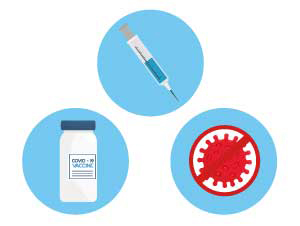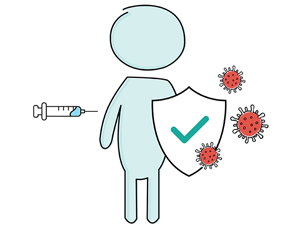How does herd immunity work?
Contagious diseases can be tricky. When someone gets sick (infected), they can pass the sickness on to others. And if the disease is highly contagious, then the sick person can infect many others—who can then go on to infect many more, and so on.
The disease will spread so long as people are susceptible to infection, meaning they have no immunity against it.
If enough people in the community become immune, however, then the infection cycle can be broken. Their immunity makes them harder to infect, which makes them less likely to catch the disease and pass it on.
Individuals can typically become immune by recovering from an infection or through vaccination—but when it comes to achieving the broad coverage required to break the infection cycle for a whole community (described below), vaccination is by far the safer, more reliable route. Mass vaccination efforts are therefore geared toward protecting as many people as possible and controlling the spread of disease.
To get a better sense of how all of this can work in real life with SARS-CoV-2, the virus that causes COVID-19, consider the three general scenarios outlined below.
Is there a difference between an infectious disease and a contagious one?
An infectious disease is one that is caused by a pathogen (germ) that infects the body and does harm
If that germ can spread from the infected person to a non-infected person, then the disease is contagious.
A contagious disease is always an infectious disease (it is caused by the infectious germ), but not all infectious diseases are contagious.
For example, tetanus is an infectious disease (caused by a bacterial infection), but it is not contagious (it does not spread from person to person).
Herd immunity only works with contagious diseases, like COVID-19.
Scenario 1: Very little immunity in the community
When too few people have immunity against the disease, it can spread throughout the community. This happens because most of the population is susceptible to infection if they get exposed to the virus.
This susceptibility is not based on age or health status. Even young and fit people are susceptible to infection simply because their bodies have not encountered the virus before. And when they get sick, they can also pass the infection to others.
In this scenario, the virus can continue to circulate in the community because it can effectively reach and infect new people.
Scenario 2: Pockets of protection
When a portion of the community gets vaccinated, those fully vaccinated individuals help to slow down the spread of the disease. Since they are harder to infect, they are far less likely to get sick and pass the infection to others.
But in this scenario, the virus can continue to circulate in the community because it can still spread easily amongst the unvaccinated people who remain susceptible to infection. Although the rates of infection (case counts) may be lower than in Scenario 1, the level of protection in the community will vary depending on what percentage of the population has been vaccinated. The higher the percentage, the better the control will be over community transmission of the disease.
Scenario 3: Happy herd
When a large enough percentage of the population has been vaccinated, the people in the community who cannot be vaccinated or who are immunocompromised end up being indirectly protected by the rest of the "herd." This phenomenon is called herd immunity.
In this scenario, the community is so full of harder-to-infect people that the virus can no longer circulate easily. The reason for this is simply that if anyone does get sick, they are more likely to be surrounded by people who are harder to infect than by people who are susceptible to infection. This limits where the virus can go, thereby disrupting the chain of infection.
And because this drastically reduces community transmission of the disease, it ultimately makes regular activities safer for everyone.
Studies are under way and researchers around the world are discussing how much vaccination coverage will be needed against COVID-19 to achieve the level of protection described in Scenario 3 (above). These studies and discussions will take into account factors like variants of concern, so some of the projections may change over time.
Overall, the thing to remember is that vaccinating as many people in Canada as possible will give us the best shot at limiting the spread of COVID-19. Your immunity is good for your community!
- Date modified:

